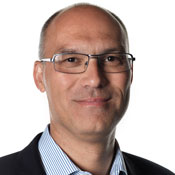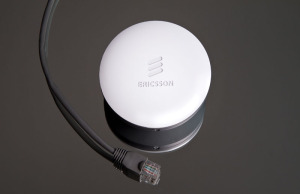Ericsson announced its in-building wireless solution – the Radio Dot system – deliberately early because it wanted to influence industry thinking on in-building coverage before it had an available product.
Although Ericsson announced the product in September 2013, it will become generally available in Q4 this year – a gap of at least 14 months from launch to shipping.
 Johan Wibergh, Executive Vice President and Head of Segment Networks, told TMN that that was a longer than usual lead time for a product, but that Ericsson felt it was necessary to influence the debate on how to provide cost-effective indoor wireless coverage and capacity.
Johan Wibergh, Executive Vice President and Head of Segment Networks, told TMN that that was a longer than usual lead time for a product, but that Ericsson felt it was necessary to influence the debate on how to provide cost-effective indoor wireless coverage and capacity.
“Normally we announce later and this was unusually big [period] in advance – there was a reason for that. We wanted to send a message to the market that this is how to build, because we thought there were different views in the industry on how to do this. We believe we have a good way of doing this … but we wanted to get the debate out in the open and if we hadn’t announced it the debate wouldn’t have come out.” Wibergh’s view is that the Radio Dot fills in a missing link in the network equipment market because it is “significantly cheaper” than alternatives yet provides the same performance as much more expensive solutions. “It has changed how we do in building coverage,” he said.
Speaking to an audience of analysts and journalists at the Ericsson Business Innovation Forum in Stockholm, Wibergh had earlier said that the Radio Dot has, to date, inspired no competitive response from other vendors.
“We launched Radio Dot over a year ago and so far no competitor has responded yet,” he said. That is not a market assessment that the likes of SpiderCloud, which insists it is ahead of Ericsson in that it has had its LTE/3G indoor small cell plus services node available since June this year, or Airvana, which launched its OneCell concept this summer, would rush to agree with. That’s not to even mention the likes of Huawei, with its Lampsite distributed radio solution, or Nokia with its FlexiZone microcells, which Nokia claims are built on the same code and therefore offer feature parity with its macrocells.
So how does Wibergh assess this competitive position, compared to Lampsite, say?
“Technically, Lampsite is a different way of doing it because that is on a CPRI interface so you need fibre going all the way out to the radio head. So it’s a more complex deployment than we have. Also, it’s quite big and things need to look beautiful. When you are wiring things up everywhere, things need to disappear a little bit.”
And DAS? There have been some indication in the market that Radio Dot is a DAS in all but name.
“Technically in DAS you have both the baseband and the radio in the basement, and then feeder cables to antennas. That’s why it’s called a Distributed Antenna System, after all. That brings much more cost per metre and more power losses in the building.” By contrast, Wibergh said, Dot Radio puts only the baseband in a central area, and then feeds the radios (via a Remote Unit) over Cat 6 cable.
Small cells? Wibergh said that the issue with small cells is that they don’t offer the same functionality, or feature parity, to the macro network whereas the Radio Dot, by working from a macro baseband, does. Also, when it is time to upgrade, an enterprise will need to replace 3G small cells with LTE, for instance. Wibergh insisted the Radio Dot can be used for both 3G and LTE with the same hardware. “It’s just a new software in the box”.
Ericsson has its own indoor small cell for slightly smaller scale indoor deployments, the recently announced RBS6402. Wibergh said this product would be generally available in March 2015. The architecture for the RBS 6402 is that for 3G it will connect directly to the RNC and on LTE will use IPSec as its communication protocol back to the core, he added.
Wibergh also confirmed that the product will be able to support three bands at any one time – so 2xLTE bands and WiFi, say. He was unsure though, if it would be able to do that using a Power over Ethernet power budget. TMN is awaiting confirmation on this point.
EDGE INTELLIGENCE?
What of another recent movement in the radio space – the formation of a Mobile Edge Computing ISG within ETSI – designed to foster standards around the siting of increased intelligence at the edge of mobile networks? Wibergh said Ericsson did not join with the likes of Nokia, Huawei and Intel because it does not agree with siting additional processing and computing resources right out at the base station.
“We believe in edge computing but it is costly to bring it to every base station. We think it should be done one step back. If you look at the hardware that’s required, processors and memory, we think it makes more sense to put it one node [further back] in [the network] versus putting it in every BTS.”
Wibergh argued that in areas where there is a mobile bandwidth limitation there is also likely to be available fibre to deploy from the network node out to the base stations. That way one node can provide edge functionality to 100-200 base stations. “But they [Nokia and MEC ISG] want to put the execution of it at the base station,” Wibergh said.
(You can see Mobile Edge Computing’s initial white paper here, if you want to compare further. Note that there are in fact different approaches for macrocell and indoor use cases).
(By the way, it’s worth noting that in an earlier talk Ericsson CTO Ulf Ewaldsson, as he discussed the way future networks could be designed to meet changing consumer needs, in fact proposed a possible use case of running a gaming app in a hybrid manner between the cloud and “some on the base station level”. This was as Ewaldsson was explaining how NFV would enable the spread of functions across the network in the future.)
CLOUD RAN
While Wibergh noted that all of Ericsson’s core elements would be virtualised by 2016, he is far from convinced that the RAN is yet a good candidate for virtualisation.
“While you may have 10-100 core sites, you are looking at tens or hundreds of thousands of base stations, all with very specialised hardware. You have to look at what makes sense in that type of architecture and it doesn’t make sense to do full virtualisation on the radio.
“If you then want to virtualise it and put it on another hardware you get very little extra benefit of putting the processing of more cells into one place. If you say, ‘Ah but you can do things [share resources] between cells, do optimisation’, well it actually doesn’t scale. Do the simulations and testing and the benefits don’t scale.”
Wibergh said that the specialised hardware in today’s base stations is very cost optimised already. Ericsson has 256 cores in its LTE base station, for example, supporting processor intensive tasks such as real time encryption, scheduling, signalling between the cell and all the devices in the site. “We tried to build this instead with Intel CPUs and you need about 10 times the CPUs to make it fly, so there are not really cost advantages in that. An Intel CPU is very expensive compared to what the whole baseband will cost.”
